Introduction of Holter Monitoring in Cardiology Unit Project
VerifiedAdded on 2023/06/09
|5
|1964
|311
Project
AI Summary
This project outlines the introduction of Holter monitoring in a cardiology unit to improve arrhythmia detection. The project's rationale emphasizes the limitations of traditional ECG monitoring and the advantages of Holter monitoring, including its portability and extended monitoring duration. The objectives are structured in short, medium, and long terms, focusing on understanding, examining, and evaluating the implementation's impact. The intended outcomes range from moderate in the short term to high in the medium term and positive in the long term, reflecting the device's ability to accurately identify cardiac irregularities. The project considers stakeholders like patients, healthcare professionals, and manufacturers, highlighting the potential for improved patient outcomes and a more efficient healthcare system. The project also includes a comprehensive list of references from journals and books to support the project's findings.
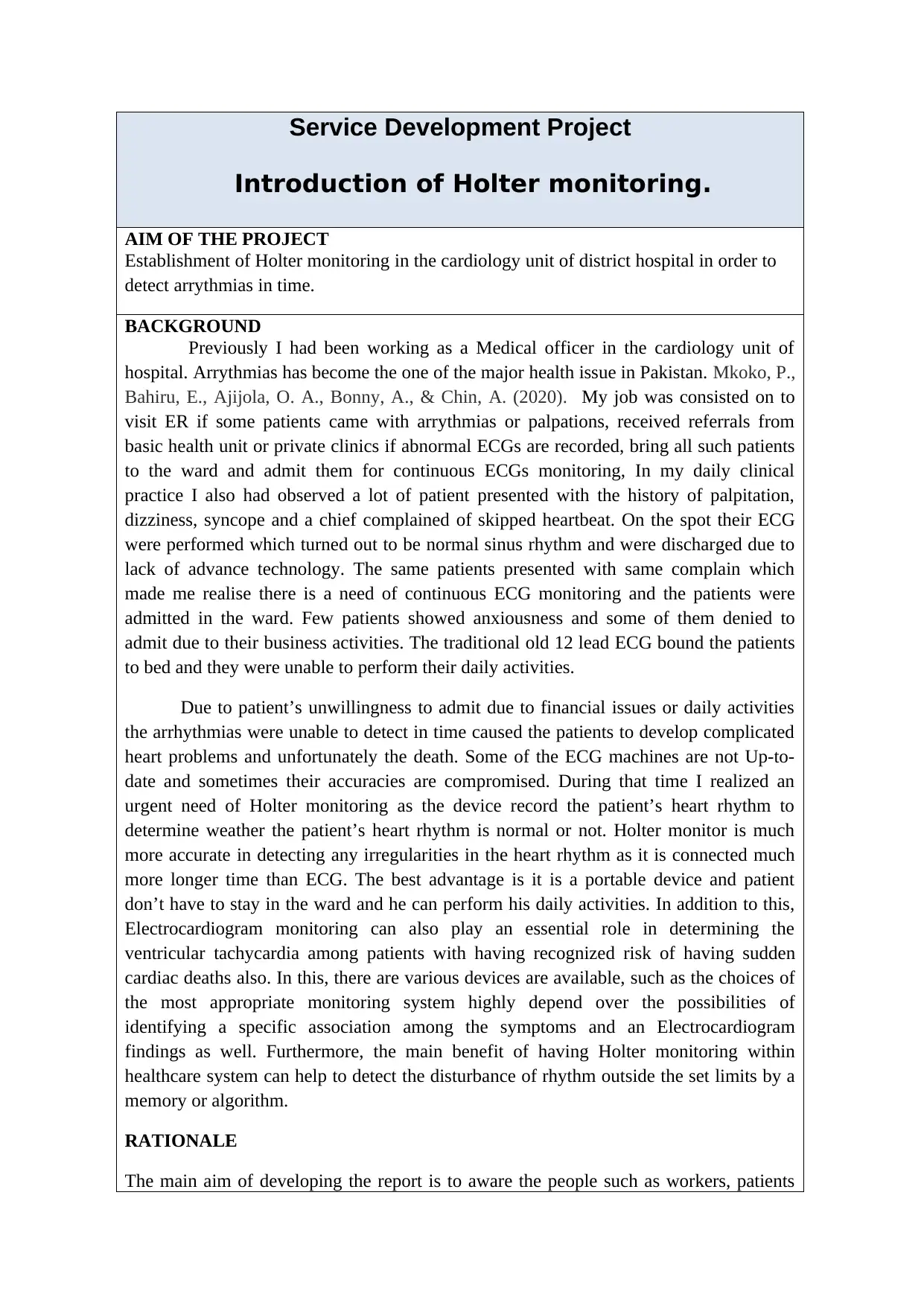
Service Development Project
Introduction of Holter monitoring.
AIM OF THE PROJECT
Establishment of Holter monitoring in the cardiology unit of district hospital in order to
detect arrythmias in time.
BACKGROUND
Previously I had been working as a Medical officer in the cardiology unit of
hospital. Arrythmias has become the one of the major health issue in Pakistan. Mkoko, P.,
Bahiru, E., Ajijola, O. A., Bonny, A., & Chin, A. (2020). My job was consisted on to
visit ER if some patients came with arrythmias or palpations, received referrals from
basic health unit or private clinics if abnormal ECGs are recorded, bring all such patients
to the ward and admit them for continuous ECGs monitoring, In my daily clinical
practice I also had observed a lot of patient presented with the history of palpitation,
dizziness, syncope and a chief complained of skipped heartbeat. On the spot their ECG
were performed which turned out to be normal sinus rhythm and were discharged due to
lack of advance technology. The same patients presented with same complain which
made me realise there is a need of continuous ECG monitoring and the patients were
admitted in the ward. Few patients showed anxiousness and some of them denied to
admit due to their business activities. The traditional old 12 lead ECG bound the patients
to bed and they were unable to perform their daily activities.
Due to patient’s unwillingness to admit due to financial issues or daily activities
the arrhythmias were unable to detect in time caused the patients to develop complicated
heart problems and unfortunately the death. Some of the ECG machines are not Up-to-
date and sometimes their accuracies are compromised. During that time I realized an
urgent need of Holter monitoring as the device record the patient’s heart rhythm to
determine weather the patient’s heart rhythm is normal or not. Holter monitor is much
more accurate in detecting any irregularities in the heart rhythm as it is connected much
more longer time than ECG. The best advantage is it is a portable device and patient
don’t have to stay in the ward and he can perform his daily activities. In addition to this,
Electrocardiogram monitoring can also play an essential role in determining the
ventricular tachycardia among patients with having recognized risk of having sudden
cardiac deaths also. In this, there are various devices are available, such as the choices of
the most appropriate monitoring system highly depend over the possibilities of
identifying a specific association among the symptoms and an Electrocardiogram
findings as well. Furthermore, the main benefit of having Holter monitoring within
healthcare system can help to detect the disturbance of rhythm outside the set limits by a
memory or algorithm.
RATIONALE
The main aim of developing the report is to aware the people such as workers, patients
Introduction of Holter monitoring.
AIM OF THE PROJECT
Establishment of Holter monitoring in the cardiology unit of district hospital in order to
detect arrythmias in time.
BACKGROUND
Previously I had been working as a Medical officer in the cardiology unit of
hospital. Arrythmias has become the one of the major health issue in Pakistan. Mkoko, P.,
Bahiru, E., Ajijola, O. A., Bonny, A., & Chin, A. (2020). My job was consisted on to
visit ER if some patients came with arrythmias or palpations, received referrals from
basic health unit or private clinics if abnormal ECGs are recorded, bring all such patients
to the ward and admit them for continuous ECGs monitoring, In my daily clinical
practice I also had observed a lot of patient presented with the history of palpitation,
dizziness, syncope and a chief complained of skipped heartbeat. On the spot their ECG
were performed which turned out to be normal sinus rhythm and were discharged due to
lack of advance technology. The same patients presented with same complain which
made me realise there is a need of continuous ECG monitoring and the patients were
admitted in the ward. Few patients showed anxiousness and some of them denied to
admit due to their business activities. The traditional old 12 lead ECG bound the patients
to bed and they were unable to perform their daily activities.
Due to patient’s unwillingness to admit due to financial issues or daily activities
the arrhythmias were unable to detect in time caused the patients to develop complicated
heart problems and unfortunately the death. Some of the ECG machines are not Up-to-
date and sometimes their accuracies are compromised. During that time I realized an
urgent need of Holter monitoring as the device record the patient’s heart rhythm to
determine weather the patient’s heart rhythm is normal or not. Holter monitor is much
more accurate in detecting any irregularities in the heart rhythm as it is connected much
more longer time than ECG. The best advantage is it is a portable device and patient
don’t have to stay in the ward and he can perform his daily activities. In addition to this,
Electrocardiogram monitoring can also play an essential role in determining the
ventricular tachycardia among patients with having recognized risk of having sudden
cardiac deaths also. In this, there are various devices are available, such as the choices of
the most appropriate monitoring system highly depend over the possibilities of
identifying a specific association among the symptoms and an Electrocardiogram
findings as well. Furthermore, the main benefit of having Holter monitoring within
healthcare system can help to detect the disturbance of rhythm outside the set limits by a
memory or algorithm.
RATIONALE
The main aim of developing the report is to aware the people such as workers, patients
Paraphrase This Document
Need a fresh take? Get an instant paraphrase of this document with our AI Paraphraser
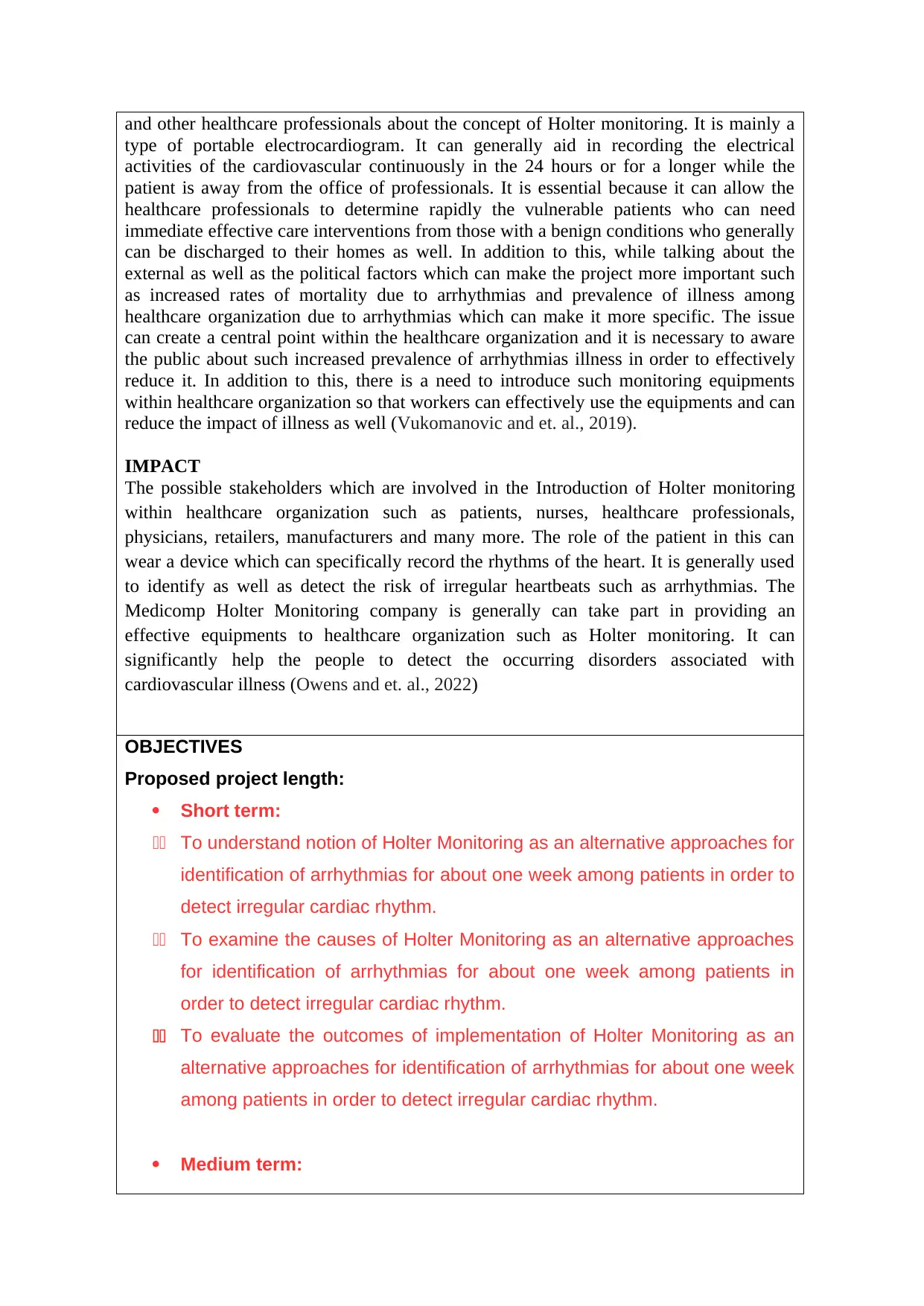
and other healthcare professionals about the concept of Holter monitoring. It is mainly a
type of portable electrocardiogram. It can generally aid in recording the electrical
activities of the cardiovascular continuously in the 24 hours or for a longer while the
patient is away from the office of professionals. It is essential because it can allow the
healthcare professionals to determine rapidly the vulnerable patients who can need
immediate effective care interventions from those with a benign conditions who generally
can be discharged to their homes as well. In addition to this, while talking about the
external as well as the political factors which can make the project more important such
as increased rates of mortality due to arrhythmias and prevalence of illness among
healthcare organization due to arrhythmias which can make it more specific. The issue
can create a central point within the healthcare organization and it is necessary to aware
the public about such increased prevalence of arrhythmias illness in order to effectively
reduce it. In addition to this, there is a need to introduce such monitoring equipments
within healthcare organization so that workers can effectively use the equipments and can
reduce the impact of illness as well (Vukomanovic and et. al., 2019).
IMPACT
The possible stakeholders which are involved in the Introduction of Holter monitoring
within healthcare organization such as patients, nurses, healthcare professionals,
physicians, retailers, manufacturers and many more. The role of the patient in this can
wear a device which can specifically record the rhythms of the heart. It is generally used
to identify as well as detect the risk of irregular heartbeats such as arrhythmias. The
Medicomp Holter Monitoring company is generally can take part in providing an
effective equipments to healthcare organization such as Holter monitoring. It can
significantly help the people to detect the occurring disorders associated with
cardiovascular illness (Owens and et. al., 2022)
OBJECTIVES
Proposed project length:
Short term:
11 To understand notion of Holter Monitoring as an alternative approaches for
identification of arrhythmias for about one week among patients in order to
detect irregular cardiac rhythm.
11 To examine the causes of Holter Monitoring as an alternative approaches
for identification of arrhythmias for about one week among patients in
order to detect irregular cardiac rhythm.
11 To evaluate the outcomes of implementation of Holter Monitoring as an
alternative approaches for identification of arrhythmias for about one week
among patients in order to detect irregular cardiac rhythm.
Medium term:
type of portable electrocardiogram. It can generally aid in recording the electrical
activities of the cardiovascular continuously in the 24 hours or for a longer while the
patient is away from the office of professionals. It is essential because it can allow the
healthcare professionals to determine rapidly the vulnerable patients who can need
immediate effective care interventions from those with a benign conditions who generally
can be discharged to their homes as well. In addition to this, while talking about the
external as well as the political factors which can make the project more important such
as increased rates of mortality due to arrhythmias and prevalence of illness among
healthcare organization due to arrhythmias which can make it more specific. The issue
can create a central point within the healthcare organization and it is necessary to aware
the public about such increased prevalence of arrhythmias illness in order to effectively
reduce it. In addition to this, there is a need to introduce such monitoring equipments
within healthcare organization so that workers can effectively use the equipments and can
reduce the impact of illness as well (Vukomanovic and et. al., 2019).
IMPACT
The possible stakeholders which are involved in the Introduction of Holter monitoring
within healthcare organization such as patients, nurses, healthcare professionals,
physicians, retailers, manufacturers and many more. The role of the patient in this can
wear a device which can specifically record the rhythms of the heart. It is generally used
to identify as well as detect the risk of irregular heartbeats such as arrhythmias. The
Medicomp Holter Monitoring company is generally can take part in providing an
effective equipments to healthcare organization such as Holter monitoring. It can
significantly help the people to detect the occurring disorders associated with
cardiovascular illness (Owens and et. al., 2022)
OBJECTIVES
Proposed project length:
Short term:
11 To understand notion of Holter Monitoring as an alternative approaches for
identification of arrhythmias for about one week among patients in order to
detect irregular cardiac rhythm.
11 To examine the causes of Holter Monitoring as an alternative approaches
for identification of arrhythmias for about one week among patients in
order to detect irregular cardiac rhythm.
11 To evaluate the outcomes of implementation of Holter Monitoring as an
alternative approaches for identification of arrhythmias for about one week
among patients in order to detect irregular cardiac rhythm.
Medium term:
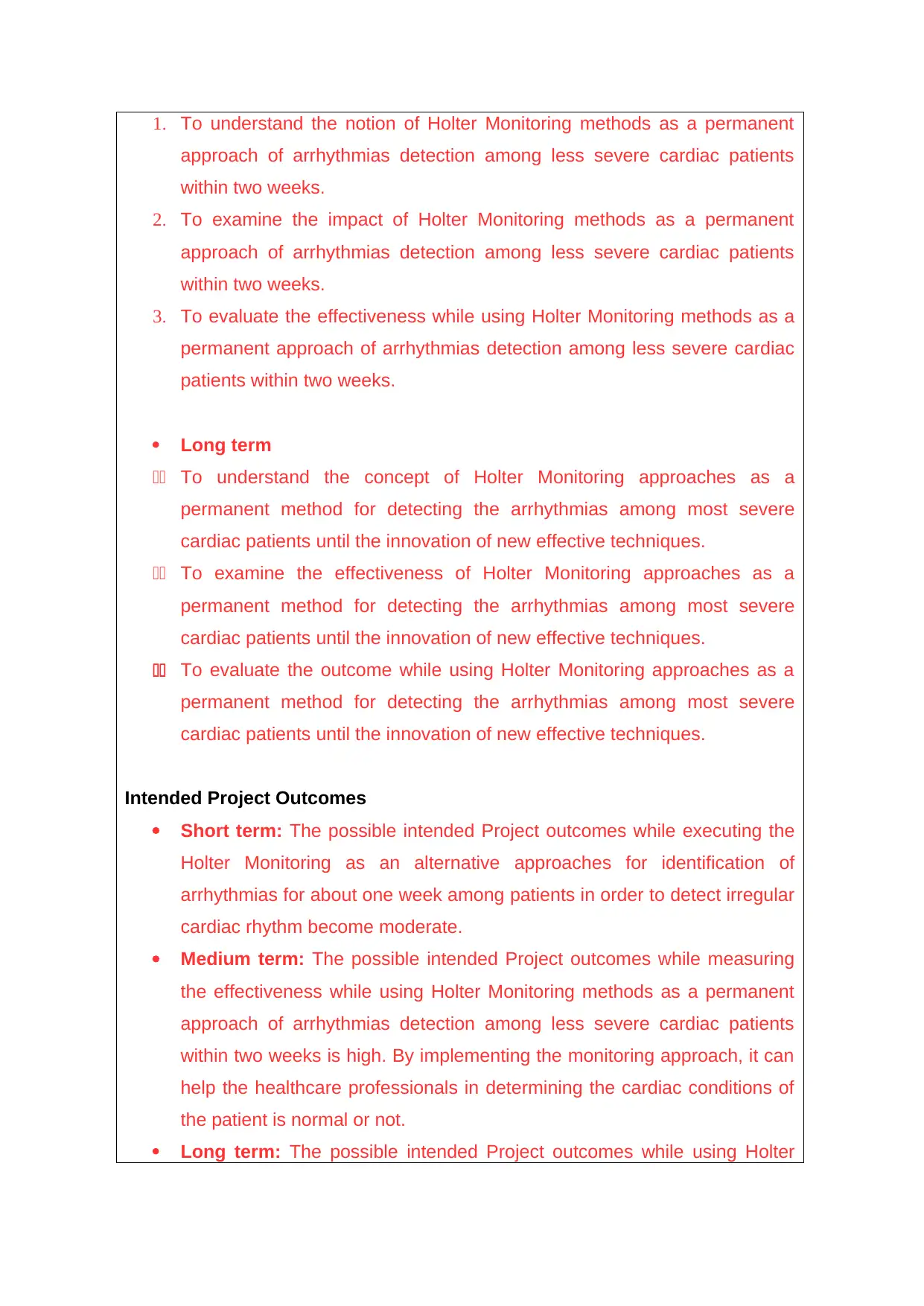
1. To understand the notion of Holter Monitoring methods as a permanent
approach of arrhythmias detection among less severe cardiac patients
within two weeks.
2. To examine the impact of Holter Monitoring methods as a permanent
approach of arrhythmias detection among less severe cardiac patients
within two weeks.
3. To evaluate the effectiveness while using Holter Monitoring methods as a
permanent approach of arrhythmias detection among less severe cardiac
patients within two weeks.
Long term
11 To understand the concept of Holter Monitoring approaches as a
permanent method for detecting the arrhythmias among most severe
cardiac patients until the innovation of new effective techniques.
11 To examine the effectiveness of Holter Monitoring approaches as a
permanent method for detecting the arrhythmias among most severe
cardiac patients until the innovation of new effective techniques.
11 To evaluate the outcome while using Holter Monitoring approaches as a
permanent method for detecting the arrhythmias among most severe
cardiac patients until the innovation of new effective techniques.
Intended Project Outcomes
Short term: The possible intended Project outcomes while executing the
Holter Monitoring as an alternative approaches for identification of
arrhythmias for about one week among patients in order to detect irregular
cardiac rhythm become moderate.
Medium term: The possible intended Project outcomes while measuring
the effectiveness while using Holter Monitoring methods as a permanent
approach of arrhythmias detection among less severe cardiac patients
within two weeks is high. By implementing the monitoring approach, it can
help the healthcare professionals in determining the cardiac conditions of
the patient is normal or not.
Long term: The possible intended Project outcomes while using Holter
approach of arrhythmias detection among less severe cardiac patients
within two weeks.
2. To examine the impact of Holter Monitoring methods as a permanent
approach of arrhythmias detection among less severe cardiac patients
within two weeks.
3. To evaluate the effectiveness while using Holter Monitoring methods as a
permanent approach of arrhythmias detection among less severe cardiac
patients within two weeks.
Long term
11 To understand the concept of Holter Monitoring approaches as a
permanent method for detecting the arrhythmias among most severe
cardiac patients until the innovation of new effective techniques.
11 To examine the effectiveness of Holter Monitoring approaches as a
permanent method for detecting the arrhythmias among most severe
cardiac patients until the innovation of new effective techniques.
11 To evaluate the outcome while using Holter Monitoring approaches as a
permanent method for detecting the arrhythmias among most severe
cardiac patients until the innovation of new effective techniques.
Intended Project Outcomes
Short term: The possible intended Project outcomes while executing the
Holter Monitoring as an alternative approaches for identification of
arrhythmias for about one week among patients in order to detect irregular
cardiac rhythm become moderate.
Medium term: The possible intended Project outcomes while measuring
the effectiveness while using Holter Monitoring methods as a permanent
approach of arrhythmias detection among less severe cardiac patients
within two weeks is high. By implementing the monitoring approach, it can
help the healthcare professionals in determining the cardiac conditions of
the patient is normal or not.
Long term: The possible intended Project outcomes while using Holter
⊘ This is a preview!⊘
Do you want full access?
Subscribe today to unlock all pages.

Trusted by 1+ million students worldwide
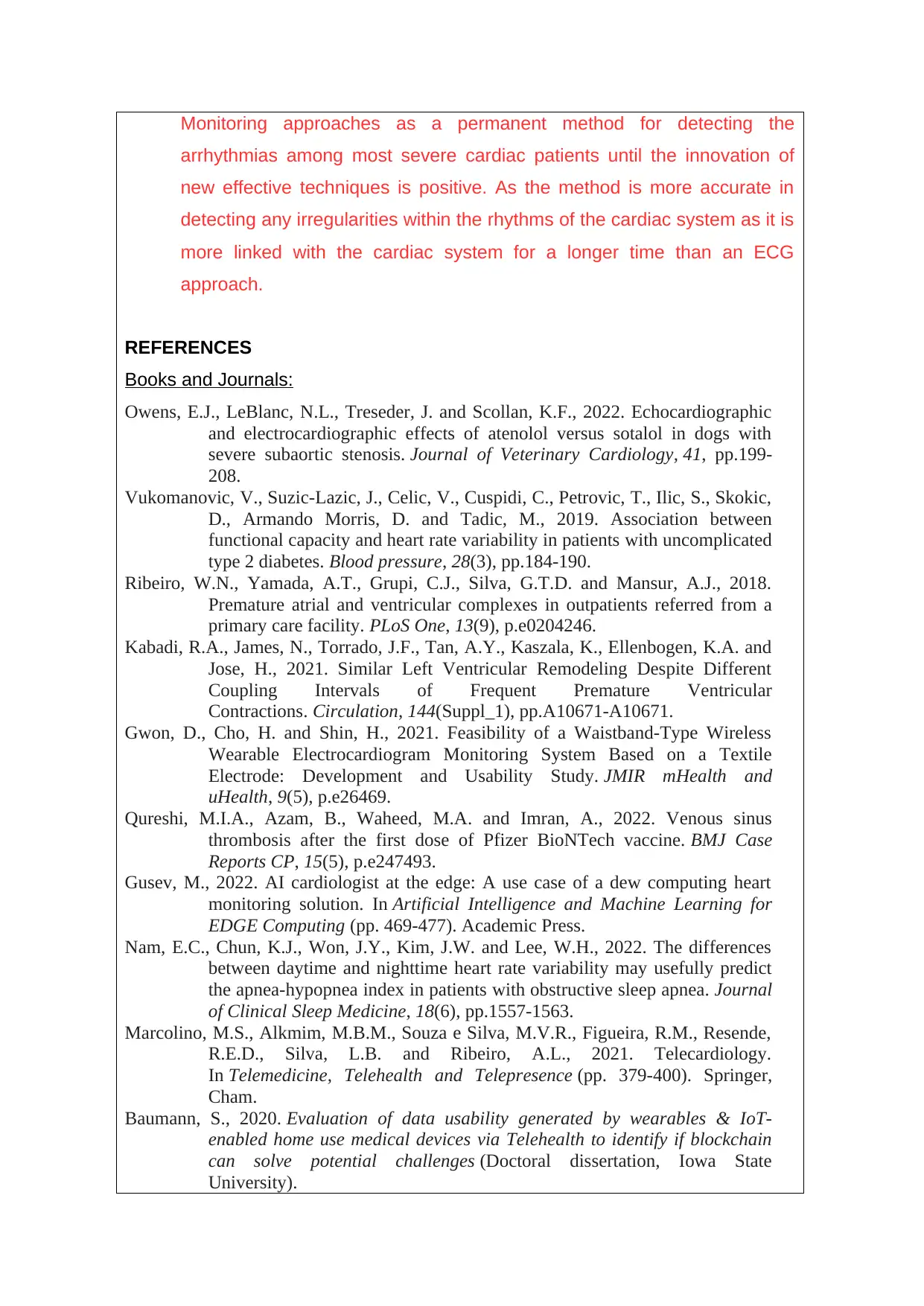
Monitoring approaches as a permanent method for detecting the
arrhythmias among most severe cardiac patients until the innovation of
new effective techniques is positive. As the method is more accurate in
detecting any irregularities within the rhythms of the cardiac system as it is
more linked with the cardiac system for a longer time than an ECG
approach.
REFERENCES
Books and Journals:
Owens, E.J., LeBlanc, N.L., Treseder, J. and Scollan, K.F., 2022. Echocardiographic
and electrocardiographic effects of atenolol versus sotalol in dogs with
severe subaortic stenosis. Journal of Veterinary Cardiology, 41, pp.199-
208.
Vukomanovic, V., Suzic-Lazic, J., Celic, V., Cuspidi, C., Petrovic, T., Ilic, S., Skokic,
D., Armando Morris, D. and Tadic, M., 2019. Association between
functional capacity and heart rate variability in patients with uncomplicated
type 2 diabetes. Blood pressure, 28(3), pp.184-190.
Ribeiro, W.N., Yamada, A.T., Grupi, C.J., Silva, G.T.D. and Mansur, A.J., 2018.
Premature atrial and ventricular complexes in outpatients referred from a
primary care facility. PLoS One, 13(9), p.e0204246.
Kabadi, R.A., James, N., Torrado, J.F., Tan, A.Y., Kaszala, K., Ellenbogen, K.A. and
Jose, H., 2021. Similar Left Ventricular Remodeling Despite Different
Coupling Intervals of Frequent Premature Ventricular
Contractions. Circulation, 144(Suppl_1), pp.A10671-A10671.
Gwon, D., Cho, H. and Shin, H., 2021. Feasibility of a Waistband-Type Wireless
Wearable Electrocardiogram Monitoring System Based on a Textile
Electrode: Development and Usability Study. JMIR mHealth and
uHealth, 9(5), p.e26469.
Qureshi, M.I.A., Azam, B., Waheed, M.A. and Imran, A., 2022. Venous sinus
thrombosis after the first dose of Pfizer BioNTech vaccine. BMJ Case
Reports CP, 15(5), p.e247493.
Gusev, M., 2022. AI cardiologist at the edge: A use case of a dew computing heart
monitoring solution. In Artificial Intelligence and Machine Learning for
EDGE Computing (pp. 469-477). Academic Press.
Nam, E.C., Chun, K.J., Won, J.Y., Kim, J.W. and Lee, W.H., 2022. The differences
between daytime and nighttime heart rate variability may usefully predict
the apnea-hypopnea index in patients with obstructive sleep apnea. Journal
of Clinical Sleep Medicine, 18(6), pp.1557-1563.
Marcolino, M.S., Alkmim, M.B.M., Souza e Silva, M.V.R., Figueira, R.M., Resende,
R.E.D., Silva, L.B. and Ribeiro, A.L., 2021. Telecardiology.
In Telemedicine, Telehealth and Telepresence (pp. 379-400). Springer,
Cham.
Baumann, S., 2020. Evaluation of data usability generated by wearables & IoT-
enabled home use medical devices via Telehealth to identify if blockchain
can solve potential challenges (Doctoral dissertation, Iowa State
University).
arrhythmias among most severe cardiac patients until the innovation of
new effective techniques is positive. As the method is more accurate in
detecting any irregularities within the rhythms of the cardiac system as it is
more linked with the cardiac system for a longer time than an ECG
approach.
REFERENCES
Books and Journals:
Owens, E.J., LeBlanc, N.L., Treseder, J. and Scollan, K.F., 2022. Echocardiographic
and electrocardiographic effects of atenolol versus sotalol in dogs with
severe subaortic stenosis. Journal of Veterinary Cardiology, 41, pp.199-
208.
Vukomanovic, V., Suzic-Lazic, J., Celic, V., Cuspidi, C., Petrovic, T., Ilic, S., Skokic,
D., Armando Morris, D. and Tadic, M., 2019. Association between
functional capacity and heart rate variability in patients with uncomplicated
type 2 diabetes. Blood pressure, 28(3), pp.184-190.
Ribeiro, W.N., Yamada, A.T., Grupi, C.J., Silva, G.T.D. and Mansur, A.J., 2018.
Premature atrial and ventricular complexes in outpatients referred from a
primary care facility. PLoS One, 13(9), p.e0204246.
Kabadi, R.A., James, N., Torrado, J.F., Tan, A.Y., Kaszala, K., Ellenbogen, K.A. and
Jose, H., 2021. Similar Left Ventricular Remodeling Despite Different
Coupling Intervals of Frequent Premature Ventricular
Contractions. Circulation, 144(Suppl_1), pp.A10671-A10671.
Gwon, D., Cho, H. and Shin, H., 2021. Feasibility of a Waistband-Type Wireless
Wearable Electrocardiogram Monitoring System Based on a Textile
Electrode: Development and Usability Study. JMIR mHealth and
uHealth, 9(5), p.e26469.
Qureshi, M.I.A., Azam, B., Waheed, M.A. and Imran, A., 2022. Venous sinus
thrombosis after the first dose of Pfizer BioNTech vaccine. BMJ Case
Reports CP, 15(5), p.e247493.
Gusev, M., 2022. AI cardiologist at the edge: A use case of a dew computing heart
monitoring solution. In Artificial Intelligence and Machine Learning for
EDGE Computing (pp. 469-477). Academic Press.
Nam, E.C., Chun, K.J., Won, J.Y., Kim, J.W. and Lee, W.H., 2022. The differences
between daytime and nighttime heart rate variability may usefully predict
the apnea-hypopnea index in patients with obstructive sleep apnea. Journal
of Clinical Sleep Medicine, 18(6), pp.1557-1563.
Marcolino, M.S., Alkmim, M.B.M., Souza e Silva, M.V.R., Figueira, R.M., Resende,
R.E.D., Silva, L.B. and Ribeiro, A.L., 2021. Telecardiology.
In Telemedicine, Telehealth and Telepresence (pp. 379-400). Springer,
Cham.
Baumann, S., 2020. Evaluation of data usability generated by wearables & IoT-
enabled home use medical devices via Telehealth to identify if blockchain
can solve potential challenges (Doctoral dissertation, Iowa State
University).
Paraphrase This Document
Need a fresh take? Get an instant paraphrase of this document with our AI Paraphraser
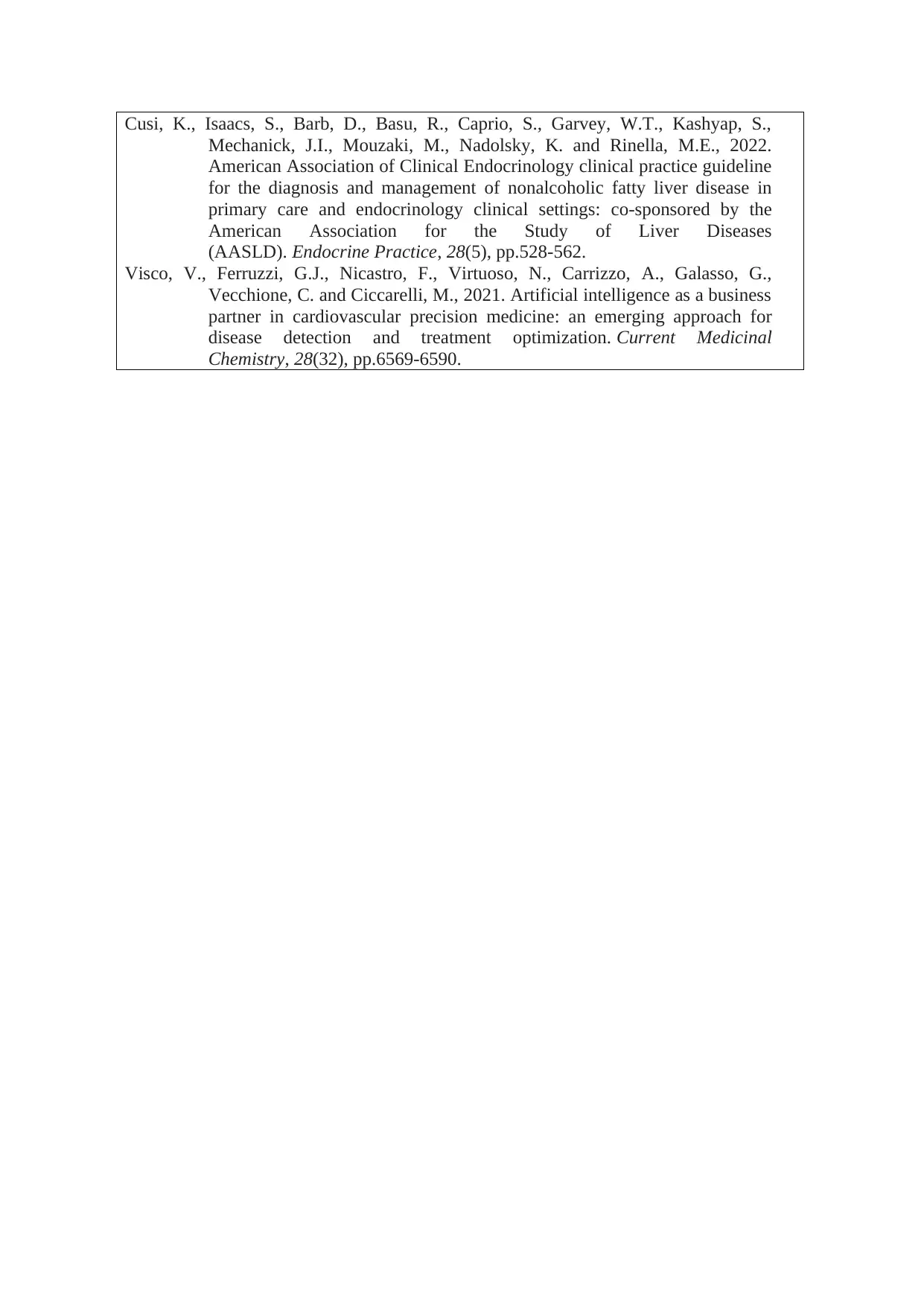
Cusi, K., Isaacs, S., Barb, D., Basu, R., Caprio, S., Garvey, W.T., Kashyap, S.,
Mechanick, J.I., Mouzaki, M., Nadolsky, K. and Rinella, M.E., 2022.
American Association of Clinical Endocrinology clinical practice guideline
for the diagnosis and management of nonalcoholic fatty liver disease in
primary care and endocrinology clinical settings: co-sponsored by the
American Association for the Study of Liver Diseases
(AASLD). Endocrine Practice, 28(5), pp.528-562.
Visco, V., Ferruzzi, G.J., Nicastro, F., Virtuoso, N., Carrizzo, A., Galasso, G.,
Vecchione, C. and Ciccarelli, M., 2021. Artificial intelligence as a business
partner in cardiovascular precision medicine: an emerging approach for
disease detection and treatment optimization. Current Medicinal
Chemistry, 28(32), pp.6569-6590.
Mechanick, J.I., Mouzaki, M., Nadolsky, K. and Rinella, M.E., 2022.
American Association of Clinical Endocrinology clinical practice guideline
for the diagnosis and management of nonalcoholic fatty liver disease in
primary care and endocrinology clinical settings: co-sponsored by the
American Association for the Study of Liver Diseases
(AASLD). Endocrine Practice, 28(5), pp.528-562.
Visco, V., Ferruzzi, G.J., Nicastro, F., Virtuoso, N., Carrizzo, A., Galasso, G.,
Vecchione, C. and Ciccarelli, M., 2021. Artificial intelligence as a business
partner in cardiovascular precision medicine: an emerging approach for
disease detection and treatment optimization. Current Medicinal
Chemistry, 28(32), pp.6569-6590.
1 out of 5
Related Documents
Your All-in-One AI-Powered Toolkit for Academic Success.
+13062052269
info@desklib.com
Available 24*7 on WhatsApp / Email
![[object Object]](/_next/static/media/star-bottom.7253800d.svg)
Unlock your academic potential
Copyright © 2020–2025 A2Z Services. All Rights Reserved. Developed and managed by ZUCOL.





